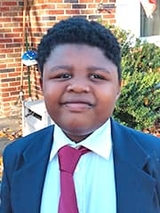Hemispherotomy Surgery to Treat Seizures: Matthew’s Story
Hemispherotomy Surgery to Treat Seizures: Matthew’s Story
When Matthew was just 4 months old, he was the victim of domestic abuse. A neighbor found him unresponsive and called 911. As Matthew was rushed to Children’s Hospital of Philadelphia’s Emergency Department, he began to have seizures.

At CHOP, Matthew was diagnosed with traumatic brain injury. He spent three months in the intensive care unit (ICU). During that time, he needed three brain surgeries, one of which was to implant a shunt to drain the excess fluid building up in his brain due to post-traumatic hydrocephalus.
Matthew was discharged from CHOP and went to live with foster parents, Joan and her husband, Ron. He had essentially just half his brain function, had vision loss on the right side of each eye, and was paralyzed on his right side. He had significant developmental disabilities and epilepsy that caused recurring seizures, which he was put on medication to control.
Struggles with anti-seizure medication

Matthew had regular follow-up appointments with CHOP specialists. It was unclear at first whether he would ever be able to walk or talk. But, with early intervention — including physical therapy, occupational therapy and speech therapy — by the time he was 2 years old, Matthew could do both.
His seizures, however, proved to be more challenging to overcome. When Matthew was 2, his neurologist weaned him off anti-seizure medication in the hopes that he no longer needed it. Matthew went a year off the medication before suffering his first grand mal seizure. Joan will never forget it, because it happened soon after she and Ron had officially adopted him. The next day, he suffered a seizure again.
Matthew was put back on a daily anti-seizure medication. But the medication dose he needed to control his seizures caused him to experience significant behavioral side effects.
“He struggled to regulate his emotions,” says Joan of Matthew’s reaction to the seizure medication. “He would have horrible meltdowns and just throw himself on the floor.”
The behavior issues severely affected his and his family’s quality of life and limited his ability to participate in school. The Neurology team tried several different anti-seizure medications, attempting to balance seizure control and side effects. But Matthew either continued to have seizures or, when a medication dose was increased, experienced intolerable side effects.
He was diagnosed with refractory focal epilepsy and admitted to CHOP for a continuous EEG to study what was going on in his brain when he experienced seizures. The EEG showed that the activity in the left hemisphere of Matthew’s brain was abnormal.
“All the left side was doing was pulling down his right side,” says Joan. “His brain was being bombarded by seizures. The diseased side of his brain was only going to cause more and more seizures and cognitive disabilities over time.”
Turning to functional hemispherotomy surgery
CHOP’s Neuroscience Center brings together world-renowned experts in both Neurology and Neurosurgery to streamline clinical collaboration and care. Matthew’s neurologist, Sara Molisani, MD, presented his case to the Center’s team and they unanimously agreed that Matthew was a perfect candidate for a functional hemispherotomy. In this surgical procedure, the abnormal side of the brain is disconnected from the healthy side of the brain and the brainstem.
By separating these connections, seizures originating in the left side of Matthew’s brain would no longer be able to spread to right, healthy half, nor could they spread to his body. The vast majority of children who have a functional hemispherotomy experience a complete resolution of their seizures.
It was a big decision for Joan and Ron to make, knowing all Matthew had already endured in his young life. But in the six months since putting their trust in the surgical expertise of Benjamin Kennedy, MD, Attending Neurosurgeon and Director of Epilepsy and Functional Neurosurgery at CHOP, 8-year-old Matthew hasn’t had a single seizure.

“It’s better than we ever anticipated,” says Joan of the outcome of the surgery. “He is so much happier. His outlook on life is so much more positive. It’s amazing what he’s doing in school. He has incredible ability with reading, spelling, memory, music, keyboarding, language skills. He’s learning Spanish.”
His expected right foot weakness after surgery is improving steadily with the help of CHOP’s specialized physical and occupational therapists, and he is running and playing again. Matthew used to be a horrible sleeper, waking up three or four times throughout the night. Now, he sleeps soundly.
“We appreciate all CHOP has done for him,” says Joan in awe. “They saved his life.”